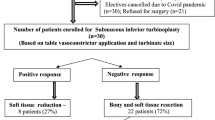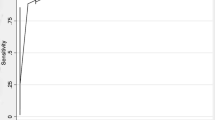Abstract
Background
Inferior turbinate hypertrophy could be a result of allergic rhinitis (AR) that leads to nasal congestion and nasal airway obstruction, which is the most bothersome complaint in patients with AR. However, evidence regarding whether patients with AR have a more hypertrophied inferior turbinate than do patients with non-AR is lacking.
Objective
We aimed to evaluate the degree of inferior turbinate hypertrophy according to the presence of AR using radiological measurements of the inferior turbinate.
Methods
For evaluating the inferior turbinate, which contributes to nasal obstruction in patients with AR, we enrolled 90 adult patients with septal deviation and divided them into two groups (AR group: n = 49; non-AR group: n = 41). Allergic rhinitis was diagnosed according to the presence of an allergic history, positive multiple allergen simultaneous test, and serological total immunoglobulin E level (≥ 100 kU/L). We analyzed the minimal cross-sectional area on acoustic rhinometry for both groups. The bilateral total width as well as medial mucosa and nasal cavity space in the anterior and posterior portions of the inferior turbinate were measured using computed tomography.
Results
We could not find any significant differences in the anterior and posterior dimensions of the inferior turbinate, intranasal space, and choanal spaces between the AR and non-AR groups. Instead, the anterior part of the inferior turbinate in both the groups showed significant differences between the deviated and contralateral sides. The contralateral side had a larger width than did the deviated side, but no significant difference was noted in the posterior portion of the inferior turbinate.
Conclusion
The degree of inferior turbinate hypertrophy showed no difference between patients with and without AR. Therefore, we suggest that surgical treatment for reducing the size of the inferior turbinate hypertrophy should be considered when performing septoplasty in patients with symptoms of nasal obstruction, regardless of the presence of AR.



Similar content being viewed by others
References
Stewart MG, Smith TL, Weaver EM, Witsell DL, Yueh B, Hannley MT, Johnson JT (2004) Outcomes after nasal septoplasty: results from the Nasal Obstruction Septoplasty Effectiveness (NOSE) study. Otolaryngol Head Neck Surg 130:283–290
Berger G, Hammel I, Berger R, Avraham S, Ophir D (2000) Histopathology of the inferior turbinate with compensatory hypertrophy in patients with deviated nasal septum. Laryngoscope 110:2100–2105
Mori S, Fujieda S, Yamada T, Kimura Y, Takahashi N, Saito H (2002) Long-term effect of submucous turbinectomy in patients with perennial allergic rhinitis. Laryngoscope 112:865–869
Mucci S, Sismanis A (1994) Inferior partial turbinectomy, an effective procedure for chronic rhinitis. Ear Nose Throat J 73:405–407
Farmer SE, Eccles R (2006) Chronic inferior turbinate enlargement and the implications for surgical intervention. Rhinology 44:234–238
Demir U, Durgut O, Saraydaroglu G, Onart S, Ocakoglu G (2012) Efficacy of radiofrequency turbinate reduction: evaluation by computed tomography and acoustic rhinometry. J Otolaryngol Head Neck Surg 41:274–281
Hamerschmidt R, Hamerschmidt R, Moreira AT, Tenório SB, Timi JR (2016) Comparison of turbinoplasty surgery efficacy in patients with and without allergic rhinitis. Braz J Otorhinolaryngol 82:131–139
Akoğlu E, Karazincir S, Balci A, Okuyucu S, Sumbas H, Dağli AS (2007) Evaluation of the turbinate hypertrophy by computed tomography in patients with deviated nasal septum. Otolaryngol Head Neck Surg 136:380–384
Egeli E, Demirci L, Yazýcý B, Harputluoglu U (2004) Evaluation of the inferior turbinate in patients with deviated nasal septum by using computed tomography. Laryngoscope 114:113–117
Orhan I, Aydın S, Ormeci T, Yılmaz F (2014) A radiological analysis of inferior turbinate in patients with deviated nasal septum by using computed tomography. Am J Rhinol Allergy 28:e68-e72
Korkut AY, Islim F, Gulseven Ciftci S, Dogan R, Gedikli O, Kahya V, Gunes G (2012) Evaluation of inferior turbinate hypertrophy in patients with congenital and traumatic nasal septum deviation. J Laryngol Otol 126:784–788
Hol MK, Huizing EH (2000) Treatment of Inferior turbinate pathology; a review and critical evaluation of different techniques. Rhinology 38:157–166
Coste A, Yona L, Blumen M, Louis B, Zerah F, Rugina M, Peynègre R, Harf A, Escudier E (2001) Radiofrequency is a safe and effective treatment of turbinate hypertrophy. Laryngoscope 111:894–899
Ercan C, Imre A, Pinar E, Erdoğan N, Umut Sakarya E, Oncel S (2014) Comparison of submucosal resection and radiofrequency turbinate volume reduction for inferior turbinate hypertrophy: evaluation by magnetic resonance imaging. Indian J Otolaryngol Head Neck Surg 66:281–286
Hytönen ML, Bäck LJ, Malmivaara AV, Roine RP (2009) Radiofrequency thermal ablation for patients with nasal symptoms: a systematic review of effectiveness and complications. Eur Arch Otorhinolaryngol 266:1257–1266
Liu CM, Tan CD, Lee FP, Lin KN, Huang HM (2009) Microdebrider-assisted versus radiofrequency-assisted inferior turbinoplasty. Laryngoscope 119:414–418
Gindros G, Kantas I, Balatsouras DG, Kaidoglou A, Kandiloros D (2010) Comparison of ultrasound turbinate reduction, radiofrequency tissue ablation and submucosal cauterization in inferior turbinate hypertrophy. Eur Arch Otorhinolaryngol 267:1727–1733
Kim JK, Cho JH, Jang HJ, Shim DB, Shin HA (2006) The effect of allergen provocation on the nasal cycle estimated by acoustic rhinometry. Acta Otolaryngol 126:390–395
Acknowledgements
This research was supported by the Basic Science Research Program through the National Research Foundation of Korea (NRF) funded by the Ministry of Education (2015R1D1A1A02062156) to H.J. Cho.
Funding
This research was supported by the Basic Science Research Program through the National Research Foundation of Korea (NRF) funded by the Ministry of Education (2015R1D1A1A02062156) to H.J. Cho.
Author information
Authors and Affiliations
Contributions
Salma Saud Al Sharhan and Lee EJ: study concept and design; drafting of manuscript; manuscript revision. Hwang CS and Nam JS: acquisition, analysis and interpretation of data; Yoon J-H and Kim C-H: revision of manuscript, approval of final version of manuscript to be published; Cho H-J: study concept and design; revision of manuscript; interpretation of data; approval of the final version of the manuscript to be published.
Corresponding author
Ethics declarations
Conflict of interest
All authors declare that they have no conflict of interest.
Ethical approval
Ethical approval was obtained from the institutional review board (IRB) of Severance Hospital.
Informed consent
Informed consent was obtained from all patients prior to their enrollment (4-2017-0645).
Rights and permissions
About this article
Cite this article
Sharhan, S.S.A., Lee, E.J., Hwang, C.S. et al. Radiological comparison of inferior turbinate hypertrophy between allergic and non-allergic rhinitis: does allergy really augment turbinate hypertrophy?. Eur Arch Otorhinolaryngol 275, 923–929 (2018). https://doi.org/10.1007/s00405-018-4893-8
Received:
Accepted:
Published:
Issue Date:
DOI: https://doi.org/10.1007/s00405-018-4893-8




